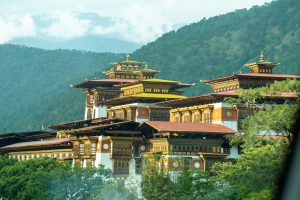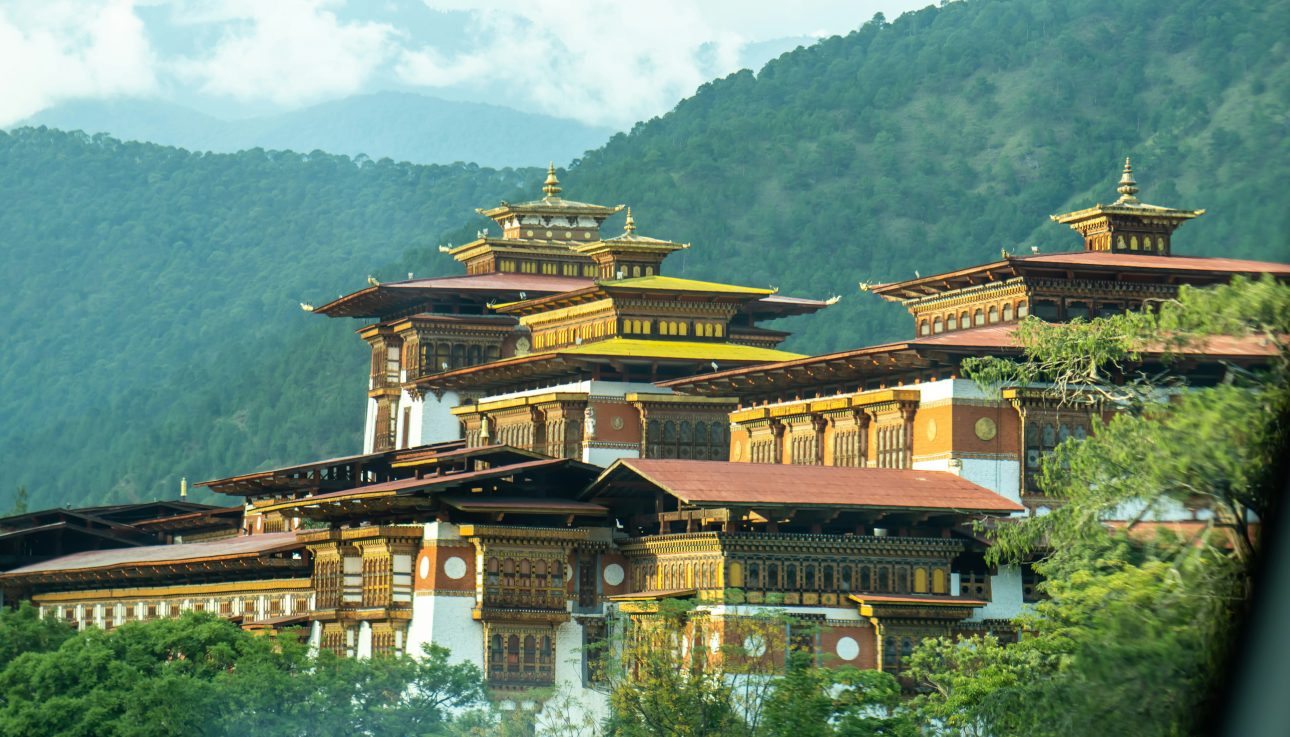Bhutan
-
General
-
Culture & Tradition
-
Enviroment
-
Climate
-
Gross National Happiness
Discover the Hidden Gem of Bhutan
Nestled in the heart of the Himalayas, Bhutan is a kingdom like no other. This enchanting country is a treasure trove of breathtaking landscapes, rich culture, and spiritual heritage. As a travel agent, you’ll want to know the essentials to craft unforgettable journeys for your clients.

Natural Beauty
Bhutan’s diverse geography ranges from lush subtropical forests to snow-capped mountains, offering endless opportunities for trekking, hiking, and exploration. The majestic Himalayas provide a stunning backdrop to the country’s pristine valleys, rivers, and waterfalls.
Culture and Heritage
Bhutanese culture is deeply rooted in Buddhism, and the country is home to numerous monasteries, temples, and dzongs (fortresses). The vibrant festivals, known as tshechus, showcase traditional masked dances, music, and art. Clients can immerse themselves in local customs by visiting sacred sites, attending festivals, and interacting with the friendly Bhutanese people.

Tourism
Bhutan’s unique tourism policy focuses on sustainable and responsible travel. Visitors can enjoy activities like trekking, birdwatching, archery, and cultural tours. The country offers various accommodation options, from luxury resorts to budget-friendly guesthouses.
Best Time to Visit
The best time to visit Bhutan is during spring (March to May) and autumn (September to November), when the weather is mild and clear. These seasons offer ideal conditions for trekking and sightseeing.
Getting There
Paro International Airport is the primary entry point, with flights connecting to major cities like Bangkok, Delhi, and Kathmandu. Clients can also enter Bhutan by road from India.
Plan Your Clients’ Dream Trip
With its breathtaking landscapes, rich culture, and warm hospitality, Bhutan is an unforgettable destination. As a travel agent, you can craft customized itineraries that showcase the best of this Himalayan kingdom. From adventure seekers to cultural enthusiasts, Bhutan has something for everyone. Start planning your clients’ Bhutanese adventure today!
Meta AI Response: Discover the Hidden Gem of Bhutan Nestled in the heart of the Himalayas, Bhutan is a kingdom like no other. This enchanting country is a treasure trove of breathtaking landscapes, rich culture, and spiritual heritage. As a travel agent, you’ll want to know the essentials to craft unforgettable journeys for your clients. Natural Beauty Bhutan’s diverse geography ranges from lush subtropical forests to snow-capped mountains, offering endless opportunities for trekking, hiking, and exploration. The majestic Himalayas provide a stunning backdrop to the country’s pristine valleys, rivers, and waterfalls. Culture and Heritage Bhutanese culture is deeply rooted in Buddhism, and the country is home to numerous monasteries, temples, and dzongs (fortresses). The vibrant festivals, known as tshechus, showcase traditional masked dances, music, and art. Clients can immerse themselves in local customs by visiting sacred sites, attending festivals, and interacting with the friendly Bhutanese people. Tourism Bhutan’s unique tourism policy focuses on sustainable and responsible travel. Visitors can enjoy activities like trekking, birdwatching, archery, and cultural tours. The country offers various accommodation options, from luxury resorts to budget-friendly guesthouses. Best Time to Visit The best time to visit Bhutan is during spring (March to May) and autumn (September to November), when the weather is mild and clear. These seasons offer ideal conditions for trekking and sightseeing. Getting There Paro International Airport is the primary entry point, with flights connecting to major cities like Bangkok, Delhi, and Kathmandu. Clients can also enter Bhutan by road from India. Plan Your Clients’ Dream Trip With its breathtaking landscapes, rich culture, and warm hospitality, Bhutan is an unforgettable destination. As a travel agent, you can craft customized itineraries that showcase the best of this Himalayan kingdom. From adventure seekers to cultural enthusiasts, Bhutan has something for everyone. Start planning your clients’ Bhutanese adventure today!
The Rich Cultural Heritage of Bhutan
Bhutan’s culture is a unique blend of Buddhist traditions, ancient customs, and modern values. The country’s cultural identity is deeply rooted in its history and is reflected in its vibrant festivals, colorful attire, and intricate art.
Buddhism
Buddhism plays a significant role in Bhutanese culture, and the country is home to numerous monasteries, temples, and sacred sites. The revered figure of Shabdrung Ngawang Namgyal, who unified Bhutan in the 17th century, is still celebrated today.
Traditional Attire
The traditional Bhutanese dress, known as “gho” for men and “kira” for women, is an integral part of the country’s cultural heritage. The gho is a long, flowing robe, while the kira is a long skirt worn with a blouse and a short jacket.
Festivals and Celebrations
Bhutanese festivals, or tshechus, are an essential part of the country’s cultural calendar. These vibrant events showcase traditional masked dances, music, and art. The most famous festival is the Paro Tshechu, which attracts visitors from around the world.
Values and Etiquette
Bhutanese people place great importance on respect, humility, and kindness. Visitors are expected to respect local customs and traditions, such as removing shoes before entering temples or monasteries, and using the right hand when giving or receiving something.
Arts and Crafts
Bhutan is renowned for its traditional arts and crafts, including painting, woodcarving, and weaving. The country’s artisans are skilled in creating intricate and beautiful pieces that reflect Bhutan’s rich cultural heritage.
Preserving Tradition
Bhutan’s commitment to preserving its cultural heritage is evident in its policies and practices. The government has implemented measures to protect the country’s traditions, language, and environment, making it a unique and fascinating destination for cultural enthusiasts.
Meta AI Response: The Rich Cultural Heritage of Bhutan Bhutan’s culture is a unique blend of Buddhist traditions, ancient customs, and modern values. The country’s cultural identity is deeply rooted in its history and is reflected in its vibrant festivals, colorful attire, and intricate art. Buddhism Buddhism plays a significant role in Bhutanese culture, and the country is home to numerous monasteries, temples, and sacred sites. The revered figure of Shabdrung Ngawang Namgyal, who unified Bhutan in the 17th century, is still celebrated today. Traditional Attire The traditional Bhutanese dress, known as “gho” for men and “kira” for women, is an integral part of the country’s cultural heritage. The gho is a long, flowing robe, while the kira is a long skirt worn with a blouse and a short jacket. Festivals and Celebrations Bhutanese festivals, or tshechus, are an essential part of the country’s cultural calendar. These vibrant events showcase traditional masked dances, music, and art. The most famous festival is the Paro Tshechu, which attracts visitors from around the world. Values and Etiquette Bhutanese people place great importance on respect, humility, and kindness. Visitors are expected to respect local customs and traditions, such as removing shoes before entering temples or monasteries, and using the right hand when giving or receiving something. Arts and Crafts Bhutan is renowned for its traditional arts and crafts, including painting, woodcarving, and weaving. The country’s artisans are skilled in creating intricate and beautiful pieces that reflect Bhutan’s rich cultural heritage. Preserving Tradition Bhutan’s commitment to preserving its cultural heritage is evident in its policies and practices. The government has implemented measures to protect the country’s traditions, language, and environment, making it a unique and fascinating destination for cultural enthusiasts.
Bhutan’s Pristine Environment
Bhutan is renowned for its stunning natural beauty and commitment to environmental conservation. The country’s pristine environment is a result of its unique approach to development, which prioritizes sustainability and Gross National Happiness (GNH) over GDP.
Biodiversity Hotspot
Bhutan is home to a diverse range of flora and fauna, with many species found nowhere else in the world. The country’s varied landscapes, from subtropical forests to alpine meadows, support a wide variety of wildlife, including snow leopards, red pandas, and golden langurs.
Conservation Efforts
Bhutan has made significant efforts to protect its environment, with over 50% of its land designated as protected areas, including national parks and wildlife sanctuaries. The country is also committed to remaining carbon neutral for all time to come.
Sustainable Practices
Bhutan’s commitment to sustainability is reflected in its policies and practices. The country promotes eco-friendly tourism, organic farming, and renewable energy, minimizing its impact on the environment.
Environmental Challenges
Despite its efforts, Bhutan faces environmental challenges, including climate change, deforestation, and wildlife-human conflict. The country continues to work towards addressing these issues while balancing economic development and environmental protection.
A Model for Sustainable Development
Bhutan’s approach to environmental conservation and sustainable development serves as a model for other countries. Its commitment to preserving its natural beauty and promoting eco-friendly practices makes it an attractive destination for environmentally conscious travelers.
Meta AI Response: Bhutan’s Pristine Environment Bhutan is renowned for its stunning natural beauty and commitment to environmental conservation. The country’s pristine environment is a result of its unique approach to development, which prioritizes sustainability and Gross National Happiness (GNH) over GDP. Biodiversity Hotspot Bhutan is home to a diverse range of flora and fauna, with many species found nowhere else in the world. The country’s varied landscapes, from subtropical forests to alpine meadows, support a wide variety of wildlife, including snow leopards, red pandas, and golden langurs. Conservation Efforts Bhutan has made significant efforts to protect its environment, with over 50% of its land designated as protected areas, including national parks and wildlife sanctuaries. The country is also committed to remaining carbon neutral for all time to come. Sustainable Practices Bhutan’s commitment to sustainability is reflected in its policies and practices. The country promotes eco-friendly tourism, organic farming, and renewable energy, minimizing its impact on the environment. Environmental Challenges Despite its efforts, Bhutan faces environmental challenges, including climate change, deforestation, and wildlife-human conflict. The country continues to work towards addressing these issues while balancing economic development and environmental protection. A Model for Sustainable Development Bhutan’s approach to environmental conservation and sustainable development serves as a model for other countries. Its commitment to preserving its natural beauty and promoting eco-friendly practices makes it an attractive destination for environmentally conscious travelers.
Bhutan’s climate varies greatly due to its complex topography and altitude variations. The country experiences four distinct seasons: spring, summer, autumn, and winter.
Seasonal Breakdown:
Spring (March to May): Mild weather with average temperatures between 10°C to 20°C (50°F to 68°F). Vibrant flora and fewer tourists make it an ideal time to visit.
Summer (June to August): Hot and humid with heavy rainfall, especially in the south. Temperatures range from 20°C to 30°C (68°F to 86°F).
Autumn (September to November): Clear skies, mild temperatures (15°C to 20°C or 59°F to 68°F), and stunning mountain views. Popular time for trekking and sightseeing.
Winter (December to February): Cold temperatures, especially in high-altitude areas, with occasional snowfall. Ideal for visiting lower regions like Punakha Valley.
Regional Climate Variations:
Southern Bhutan: Tropical climate with temperatures between 15°C to 30°C (59°F to 86°F).
Central Bhutan: Subtropical climate with cool winters and warm summers.
Northern Bhutan: Harsh climate with snowfall and sub-zero temperatures.
Best Time to Visit:
The best times to visit Bhutan are during spring (March to May) and autumn (September to November), when the weather is pleasant and ideal for outdoor activities ¹.
Gross National Happiness (GNH)
Bhutan’s unique approach to development prioritizes Gross National Happiness (GNH) over Gross Domestic Product (GDP). This philosophy, introduced by the Fourth King of Bhutan, aims to create a society that values well-being, sustainability, and happiness.
Four Pillars of GNH:
Psychological Well-being: Promoting mental health, mindfulness, and emotional well-being.
Physical Health: Ensuring access to quality healthcare and promoting healthy lifestyles.
Education: Fostering knowledge, skills, and values that contribute to a fulfilling life.
Living Standards: Ensuring a decent standard of living, economic security, and environmental sustainability.
Nine Domains of GNH:
Psychological well-being
Health
Education
Time use
Social relationships
Cultural diversity and resilience
Environmental conservation
Good governance
Material well-being
GNH in Practice:
Bhutan’s commitment to GNH is reflected in its policies and practices, such as:
Sustainable tourism
Environmental conservation
Organic farming
Renewable energy
Cultural preservation
Impact:
GNH has contributed to Bhutan’s unique development path, prioritizing:
Happiness and well-being over material wealth
Sustainability and environmental stewardship
Cultural preservation and community cohesion
A Model for Development:
Bhutan’s GNH approach serves as a model for alternative development paradigms, inspiring other countries to rethink their priorities and values.
Meta AI Response: Gross National Happiness (GNH) Bhutan’s unique approach to development prioritizes Gross National Happiness (GNH) over Gross Domestic Product (GDP). This philosophy, introduced by the Fourth King of Bhutan, aims to create a society that values well-being, sustainability, and happiness. Four Pillars of GNH: Psychological Well-being: Promoting mental health, mindfulness, and emotional well-being. Physical Health: Ensuring access to quality healthcare and promoting healthy lifestyles. Education: Fostering knowledge, skills, and values that contribute to a fulfilling life. Living Standards: Ensuring a decent standard of living, economic security, and environmental sustainability. Nine Domains of GNH: Psychological well-being Health Education Time use Social relationships Cultural diversity and resilience Environmental conservation Good governance Material well-being GNH in Practice: Bhutan’s commitment to GNH is reflected in its policies and practices, such as: Sustainable tourism Environmental conservation Organic farming Renewable energy Cultural preservation Impact: GNH has contributed to Bhutan’s unique development path, prioritizing: Happiness and well-being over material wealth Sustainability and environmental stewardship Cultural preservation and community cohesion A Model for Development: Bhutan’s GNH approach serves as a model for alternative development paradigms, inspiring other countries to rethink their priorities and values.
